The Vamo is one of the most well-known VV/VW mods on the market, now on its fifth incarnation and still much-loved by vapers around the world, but is it really worth the purchase when there are so many dependable and capable mods available?

The Vamo is a consistently popular VV/VW mod. It doesn’t have the most interesting design, it might not be the easiest thing to take around with you, and you might be unlucky and run into trouble with a sinking center pin or threading problems, but it’s usually well-received for a reason.
It does everything you want it to, has a wide wattage range and powers most atomizers quickly and effectively; it might not blow you away, but for the price (especially if you can get one for under $30) it’s an absolute bargain. If you have an older Vamo, it might not be worth upgrading for the minimal changes, but if this is your first you’re unlikely to regret the purchase.

There is a lot of competition when it comes to VV/VW mods. From affordable box mods such as the iTaste MVP right through to other tube options like the ProVari, it’s not like we’re starved for choice. Choosing your ideal mod isn’t an easy task, but there are some devices people consistently seem to shower with praise. The Vamo is one of the most well-known VV/VW mods on the market, now on its fifth incarnation and still much-loved by vapers around the world, but is it really worth the purchase when there are so many dependable and capable mods available?
The Vamo is made in China, but the manufacturer can differ. There are several factories in China which make them, so there is no individual maker of authentic Vamos. This isn’t ideal if you’re the sort of person who likes to find out about whose products you’re buying, but for most Chinese companies you’ll only usually find claims of high quality products written in broken English anyway. SmokTek has them available for $49.95 (at time of writing), and you can pick one up from other places like FastTech too (currently $24.25).
The Vamo V5 has a few small improvements over previous versions, but is it worth upgrading if you have one of the older versions? And can it stand on its own two feet as a VV/VW mod? We’ve put it to the test to find out.
What You Get

The Vamo V5 doesn’t really come with anything. You get the mod in a fairly basic cardboard box with “Vamo” written across it in black letters. Of course, you’re only intending to buy the mod, and you can pick it up for cheap enough that you wouldn’t expect any extras, but a battery or even a clearomizer would be a nice addition for anyone new to VV/VW devices. Depending on your vendor, you might be able to pick up some extras alongside it, but as standard you get nothing but the mod.
Design and Compatibility
The Vamo V5 is pretty basic in design, a fairly standard-looking tube mod that has no major differences from the previous incarnations. On the V3, there was a spiraling groove stretching up the body of the mod, but it’s now smooth in the same way as every other version has been. It comes in black, brushed stainless steel and chrome, with mine being the latter version. The chrome has a shiny, polished finish which stands up reasonably well to scuffs and scrapes – if you accidentally knock the bare mod against stone or brick it’ll scratch, but in ordinary situations it’ll hold up well (aside from the odd finger-mark, that is). The black version doesn’t take as well to scratches, though, so keep that in mind if you’re both clumsy and particular about appearance.
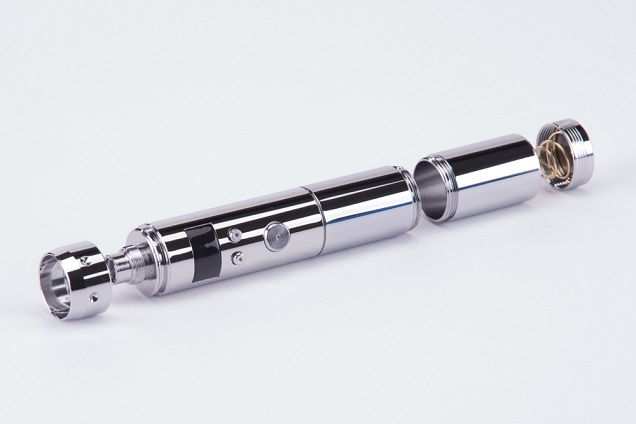
The Vamo’s body is split up by horizontal grooves where the various sections connect to one another. There’s a simple bottom-cap (which has a touch of decoration in the form of four parallel grooves wrapping around it, as well as a vent hole in the bottom), two battery sections (the bottom of which can be removed to change battery size), the user interface section and a removable “beauty ring” to cover up the full eGo threading hiding beneath the 510 connection. For connectivity, this means that you can use most atomizers and clearomizers on the market, so there are no complaints there. The beauty ring tapers in a little at the top, unlike on original Vamos, and leaves more room in the center (about 19 mm in total) for wider cartomizers.
From bottom cap to top, the Vamo V5 measures around 5 and 1/2 inches (14.1 cm) in 18650 mode and 4 and 1/4 inches (10.8 cm) in 18350 mode. In 18650 mode, it’s pretty long and isn’t so easy to carry around without a bag or a mod holster. Switching between modes is quick and simple, though, so you can always use 18350 mode if you find it a pain to carry around. It’s about the same size as many 18650 VV/VW tube mods, but a touch taller than things like the ProVari or the Joyetech eVic. If you prefer, you can use it with two 18350 batteries (for increased output voltage), but stacking small batteries is inherently more risky than using one big one, so (despite the in-built protections on the Vamo) this isn’t really advised unless you know what you’re doing.
The Vamo V5 vape mod has three buttons (two small ones for “+” and “−,” with a larger fire button below; looking a little like a shocked mouth with two beady eyes) and a horizontally-orientated display screen. It’s simple but effective, being intuitive to get to grips with and easy to physically operate, and the fact that you can read the screen without turning the mod on its side is a plus-point too. The OLED screen is much crisper and visually appealing than the older, figure-8 style LCD display, and sits a little more flush to the surface of the mod (although still protruding a little).
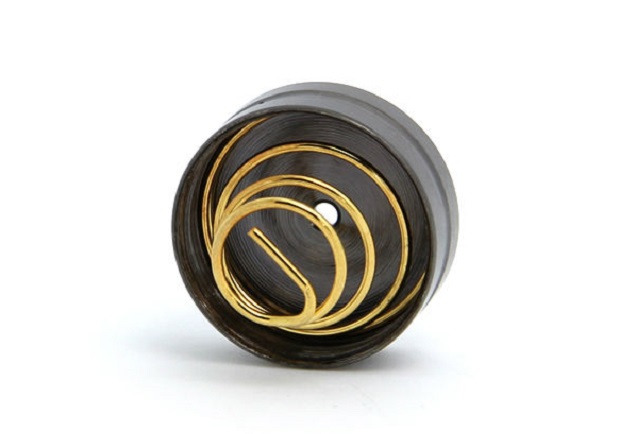
The bottom cap’s spring was previously an issue, having too much resistance and heating up in use, but this problem has been fixed. Similarly, some users complained that the spring was weak and needed re-stretching occasionally to prevent connection issues. The new gold spring is sturdy and never gets hot, and you can use flat-topped or button-topped batteries with no problems.
Overall, the Vamo V5 vape mod does pretty well in this department, with a simple but logical design – it isn’t anything astounding but it gets the job done.
Features
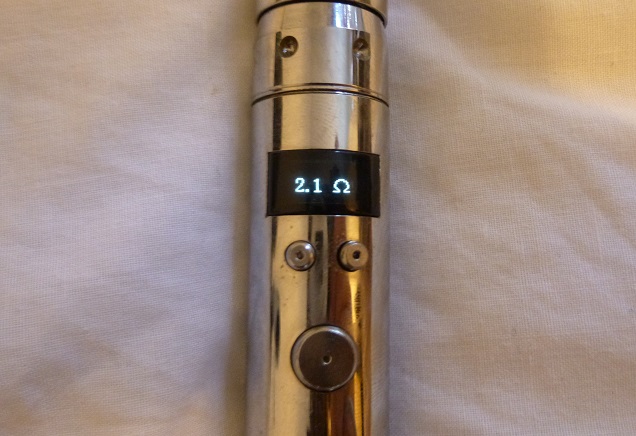
The Vamo V5 has all of the features we’ve come to expect from VV/VW devices: an onboard resistance checker, battery level indicator (shown through the remaining voltage) and in-built safety features. Holding the “–” button brings up your current battery level in volts, and holding the right (“+”) button down shows your current atomizer’s resistance (followed by an Ω sign). Five quick presses of the fire button also turns the unit on or off, indicated by “System: On” (or “Off”) showing on the display.
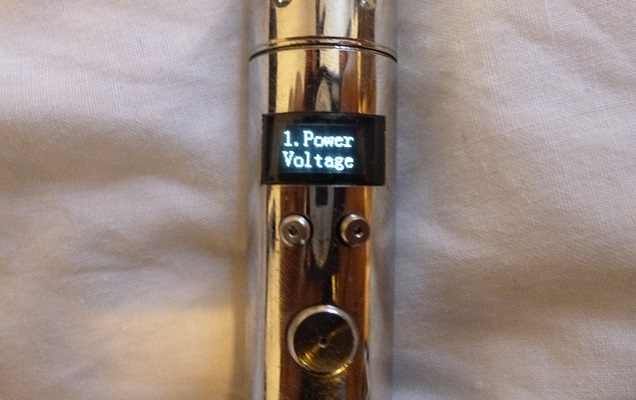
You can adjust the power you’re sending to the atomizer in either volts or watts, which you can change by going into the menu (by holding down the “+” and “−” buttons together), selecting “Power Voltage” (which should really be separated with a forward-slash for clarity) and then switching to the appropriate option. Voltage is adjusted in 0.1 V increments from 3 to 6 V, and wattage is adjusted in 0.5 W increments from 3 to 15 W. When you turn the unit off (and/or remove the battery) it’ll remember the power or voltage you have set in your current mode, but you can’t have one set power and one set voltage and change between the two, even if the device stays on. It remembers one of your settings (the power seems to take precedence), but the other will reset.
The safety features on the Vamo protect you if you put the battery in the wrong way (as always, the positive, button end goes in first and sits closest to the top), the device shuts down if the fire button is activated for more than 10 seconds in one puff and it refuses to fire if it detects a short circuit. In addition, there is a thermal monitoring system which causes the Vamo to shut down if the temperature goes too high (although I’m yet to run into this) and the unit will also shut down if your battery dies.
The remainder of the menu system offers a couple more features. When you hit fire, the screen displays your current voltage or power setting as standard, but you can also change this to show either your atomizer resistance or the remaining charge left in the battery. The final option in the menu allows you to turn the OLED screen off but still be able to vape, which is useful if you vape in bed but don’t want to annoy your partner with intermittent light.
Some Vamo V5s also have an option to change between RMS output mode or mean average, but mine came in one-mode (RMS) only. RMS means “root mean squared,” and basically provides a more accurate output (i.e. truer to your selected voltage or power) than the mean average mode (which is a less stringent way to judge it’s accuracy with respect to your desired setting), meaning the power delivery, and consequently vapor production, can vary quite notably. Although you may prefer average mode, it’s hard to see why anyone really would (which is why they started producing Vamos without the option) – if yours has both options you can set it to RMS (hold down the “–” key for 10 to 15 seconds to bring it up) and pretty much leave it alone from that point onwards.
Overall, the features of the Vamo V5 e-cig mod are fairly basic, but do everything vapers need without adding on pointless extras like puff counters, time and date displays and other eVic-esque functions.
Hardware Limitations
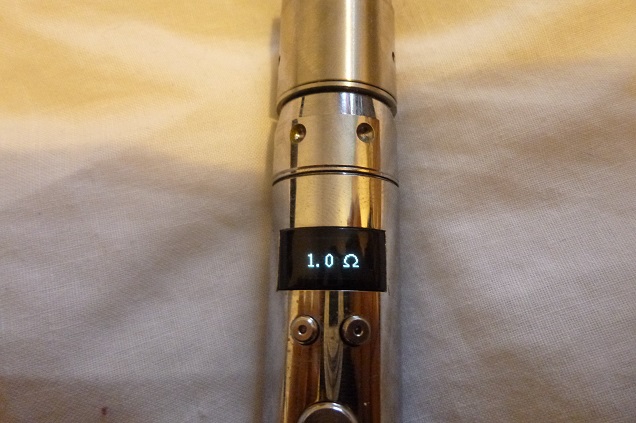
For many vapers, sub-ohming isn’t such a big deal, and unless you really want humongous clouds it’s hard to imagine you being disappointed with the Vamo’s capabilities. The minimum resistance it will fire is 1.2 ohms, and it has a current limit of 5 amps. In actual fact, the voltages supplied change between around 2 and 6 V intermittently, and you can see the square wave form on the results of Phil Busardo’s hardware tests. When you adjust the voltage, all you do is increase the amount of time the higher voltage fires for. This isn’t such a big deal for me personally, but some vapers find the intermittent bursts of higher voltage a little harsh and prefer a flat output signal.
Generally speaking, the testing also showed that unless you’re getting low on resistance (the lowest in the test was 1.5 ohms) and high on voltage (in the 5.5 to 6 V range) the delivered voltage matches the stated voltage very accurately. Using two stacked 18350s the delivery is much more accurate in these cases, though (if you do this, use high-quality batteries that are only ever used as a pair, kept at the same charge level – there’s more on this in our mod safety articles). As always, if you want super-low resistance you’ll be better off with a mechanical mod, as long as you know your battery limitations, understand Ohm’s law and know why all this stuff is important, that is.
For most VV/VW vapers, there is no problem whatsoever with the Vamo’s capabilities. 15 watts is plenty of power to send to an atomizer; personally, I’m happy with anything from 9 to 11 W most of the time, so I didn’t approach any limitations in ordinary use. There are VV/VW devices that have more range than this (there’s even a 30 watt Vamo), but for an affordable mod it’s very good indeed.
In Use
The Vamo is definitely user-friendly. There is only one menu, and unless you want to mess around with what shows up (if anything) on the display screen, all you’ll really need to use it for is to occasionally switch from voltage mode to wattage mode or vice-versa. For most of the operations, it’s really simple: hold down the “−”or “+” key to bring up your battery level or resistance, and use them as you’d expect to adjust the voltage or power. Since you have a “+” and a “−” key (unlike on the MVP or ProVari, for example) and it cycles round when you reach a boundary, adjusting your power is about as efficient as it gets. There’s no auto-scroll, but you don’t really miss it.
It’s definitely dependable, and as long as you don’t build low-ohm coils it’ll fire most atomizers, clearomizers and tanks you attach. The performance is consistently great, too, and although some might not like the oscillating voltage, to me it seems to make it heat up and produce vapor a little more quickly and efficiently than other devices like the iTaste MVP or SVD (using exactly the same setup). It isn’t a huge difference, but the Vamo V5 definitely works well.
It’s not quite as portable as you may like in 18650 mode, though, and that does make it a little more awkward for taking to work or out to a bar. Most vapers are used to this, though, and the difference in length between the Vamo and other 18650 mods is really quite minimal in practice. Plus, if portability is an issue you can put it in 18350 mode and get it into a pocket more comfortably.
Apart from the manufacturing issues covered below (with some users struggling with a sinking center pin or problems with the threading) it’s hard to fault the Vamo in use. There are some minor annoyances – like the fact that you can’t check the power or voltage setting you’re currently on without either firing the device or changing it one increment up or down – but nothing that really takes much away from the device.
Manufacturing Quality
Generally speaking, the manufacturing quality is quite good on the Vamo V5 vape mod. With the updates to the design, some of the problems that plagued the older versions have been rectified, everything screws together snugly and the buttons are easy to push without being too stiff. There are some lingering imperfections, such as the slight rattle of the fire button and the slightly sloppy-looking groove where the main body of the mod connects to the beauty ring, but overall everything seems to be well-built. It’s a sturdy mod, all in all, with the steel construction providing a dependable, solid feel.
The main issue vapers have with the manufacturing quality is with the center pin, which can get pushed down if you tighten your atomizer, tank or clearomizer on too tightly or with certain devices. This is easy enough to fix (just get something thin and gently wiggle it back up), and wasn’t an issue during my testing, so you may not even encounter it. The threading has also been the source of some complaint (especially on older Vamos), but as long as you’re careful when you attach your devices it doesn’t seem to be an issue, again not being evident with the device I tried. You can also use an airflow controller to preserve the threads if you’re concerned.
The manufacturing quality isn’t always ideal, and this is likely a consequence of it being made by numerous manufacturers. The one I tried out didn’t seem to suffer from any major issues, but there’s a chance that this is simply luck, since many other users have had problems.

